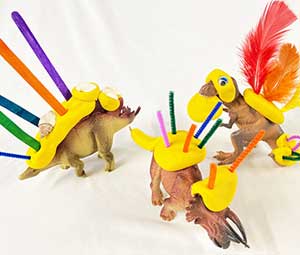Dough & Dinos

Decorate your dinosaurs and create play accessories from loose parts.
What are loose parts? Loose parts are open-ended and versatile materials that can be used in a variety of ways. They can be found, bought, taken out of your recycling bin, or even taken from other art projects and repurposed. With loose parts children can use their imaginations to create in endless ways. Some examples of loose parts can be found in our materials list below.
Decorate your dinosaurs and create play accessories from loose parts.What are loose parts? Loose parts are open-ended and versatile materials that can be used in a variety of ways. They can be found, bought, taken out of your recycling bin, or even taken from other art projects and repurposed. With loose parts children can use their imaginations to create in endless ways. Some examples of loose parts can be found in our materials list below.
Ages/Grades
Toddler, Preschool, Early Elementary
Learning Domains
Science, Fine Motor, Language
Materials
• Large plastic dinosaurs (can be done with any animals)
• Pom poms
• Feathers
• Any collage materials such as; buttons, beads, fabric and felt
• Objects found in nature - seeds, sticks, samaras (Maple tree seeds), pebbles, acorn tops, etc. (optional)
Ready, Set, Create!
![]() Place the dinosaurs, modeling dough, and loose parts out on your work surface.
Place the dinosaurs, modeling dough, and loose parts out on your work surface.
![]() Organize the materials in an interesting and enticing way, to create an “Invitation to Create.” Arrange the dough into neat balls and organize the loose parts (by color, shape or size) and place them in attractive containers such as shallow bowls.
Organize the materials in an interesting and enticing way, to create an “Invitation to Create.” Arrange the dough into neat balls and organize the loose parts (by color, shape or size) and place them in attractive containers such as shallow bowls.
![]() Encourage children to press modeling dough onto the dinosaurs. Loose parts, when pressed into the dough, will stick to the dinos.
Encourage children to press modeling dough onto the dinosaurs. Loose parts, when pressed into the dough, will stick to the dinos.

![]() Children can create imaginative play scenarios using their dinosaurs, the dough, and the loose parts.
Children can create imaginative play scenarios using their dinosaurs, the dough, and the loose parts.
Engage Children in Conversation
Comment on what you observe, such as “I notice you added dough to the dinosaur’s face” or “I see you placed chenille stems all the way the dinosaur’s back.”
Ask children open ended questions that encourage critical thinking, such as:
Which materials will you use with your dinosaur? Why will you choose these materials?
I’m wondering why you added (these materials) to this (part of your dinosaur).
Will you create food for your dinosaur? What will it eat
For very young children, try asking “either/or” questions, such as “are you using the blue or the orange dough?”
Extensions
Children can use these materials with any plastic animals, depending upon their interests, the unit of study, or materials available.
Craft sticks, modeling dough, and other materials can be used to create habitats for dinosaurs. These creations can be 3D or created flat on paper.
Modifications
![]() Try using large and more easily grasped loose parts with the dough, as well as smaller pieces so that children have a variety of options depending upon their motor abilities.
Try using large and more easily grasped loose parts with the dough, as well as smaller pieces so that children have a variety of options depending upon their motor abilities.
![]() You can also offer dough tools, such as rollers or stampers so that they can mold the dough without using their hands.
You can also offer dough tools, such as rollers or stampers so that they can mold the dough without using their hands.
![]() Offer children large dinosaurs, as well as very small ones, to mix things up.
Offer children large dinosaurs, as well as very small ones, to mix things up.
